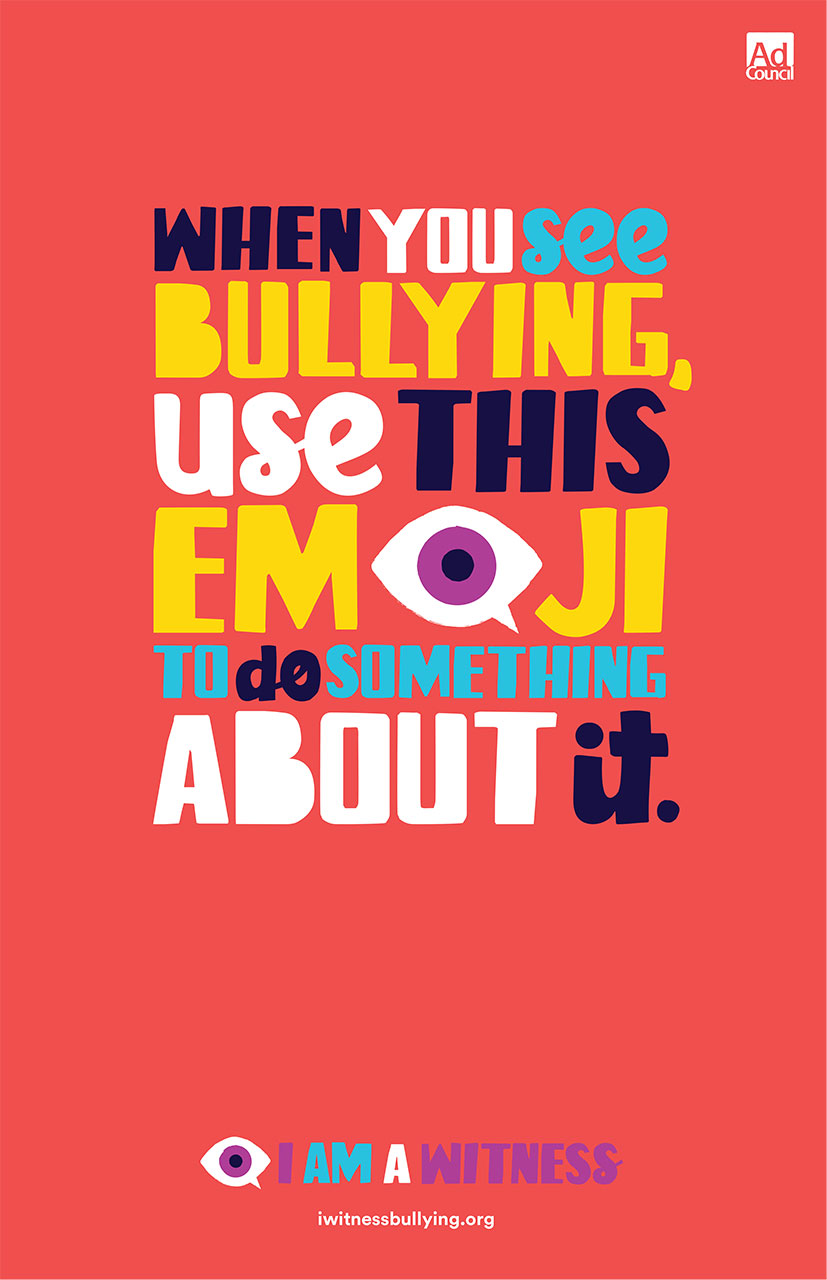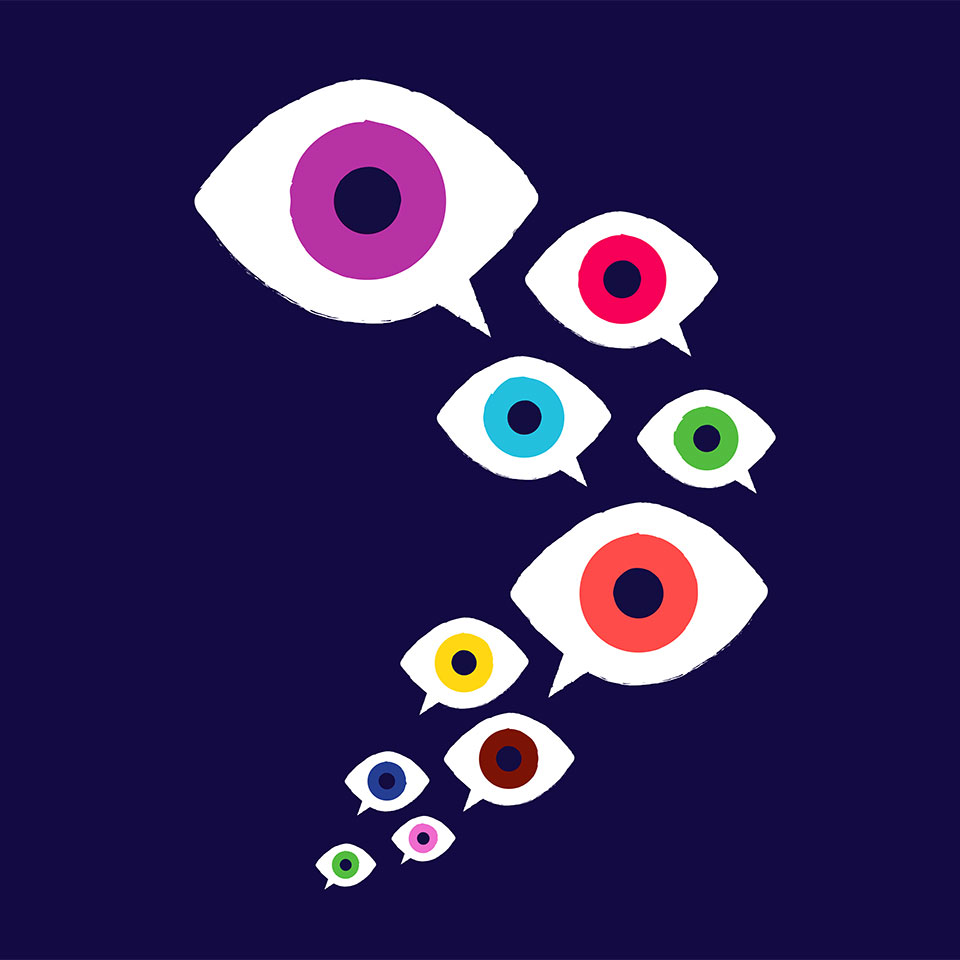
A number of anti-bullying campaigns have rolled out in recent years, with most of the messaging aimed either at the victims or the bullies themselves. But now, Adobe is teaming with the Ad Council, agency Goodby Silverstein & Partners and a host of media companies to launch an anti-bullying effort that speaks to a new target—and gives them a clever new language to help make a difference.
The target is people who witness bullying. The new language is the first Unicode Standard approved emoji ever created for a social cause—an eye inside a speech bubble that's meant to be used when people see bullying, and want to speak out against it in some way.
 The emoji, which was a mystery when it appeared in the developer preview of iOS 9.1 last month, has now launched on Apple's keyboard. (Those who have the current iOS 9.1 will see it appear automatically.) It's not available natively on Android yet, though Android users will be able to download a special keyboard, developed pro bono by Snaps, that has similar imagery.
The emoji, which was a mystery when it appeared in the developer preview of iOS 9.1 last month, has now launched on Apple's keyboard. (Those who have the current iOS 9.1 will see it appear automatically.) It's not available natively on Android yet, though Android users will be able to download a special keyboard, developed pro bono by Snaps, that has similar imagery.
The larger campaign, called "I Am A Witness," was developed pro bono by GS&P, Adobe and the Ad Council—with support from powerful media partners Apple, Facebook, Google, YouTube, Johnson & Johnson and Twitter, all of whom will provide exposure and customized content on their own platforms.
Several videos, meanwhile, will generate awareness for the campaign and the emoji.
One is an animated, interactive spot about a kid named Jack who is being bullied. It was created by Moonbot Studios (which also did Chipotle's famous "Scarecrow" spot) with music from Devo's Mark Mothersbaugh. When the user interacts with the video using the onscreen emoji, the boy's bleak world is suddenly filled with more color.
The other spot is a long-form video showing popular YouTube stars reading mean comments about themselves, and then speaking out against bullying. See both spots here:
The whole project started at Adobe, whose CMO, Ann Lewnes, is highly committed to the anti-bullying cause. Last year, she and Adobe launched a project inspired by Lee Hirsch's documentary Bully. This year, Adobe approached its agency, GS&P, looking for a way to extend the message. And the new work also ended up being inspired by Bully.
"We saw this scene in the movie where this kid was getting bullied on a bus," Cassi Norman, the Adobe account director at GS&P, told Adweek. "We stopped ourselves and said, 'Yeah, there's a kid being bullied. And there's a bully. But what about all these kids that are witnessing it and not doing anything?' "
Norman added: "A lot of these campaigns speak to victims and bullies. But we know there's witnesses out there. If we could activate them in some way, they could be a much more powerful tool in stopping bullying happening. That was the driving insight."
GS&P copywriter Kate Baynham said the agency leaned toward the idea of an eye for the emoji from the very beginning, even though the image does carry some baggage. (Apple designed the actual emoji itself, based on GSP's other campaign materials.)
"Obviously the eye is a very strong symbol," Baynham said. "We've had questions like, 'Are you worried about drawing connotations to Big Brother or anything like that?' But so often, victims of bullying feel completely isolated and unseen. And bullies feel empowered to bully because they feel like they might be a little anonymous. By making the symbol an eye, it's like, 'No, I see what you're doing.' It's about accountability."
 The eye is also a useful mark as it can adapt to many contexts in which it could be used.
The eye is also a useful mark as it can adapt to many contexts in which it could be used.
"We wanted to give these a teenagers a tool that's pretty flexible in however they want to use it," Norman said. "Whether it's bringing kindness or support to the person who's experiencing the bullying, or calling it out, or just saying 'I don't stand for it,' it's a flexible symbol that can adapt to those different needs."
Creating and encouraging use of an emoji was attractive in another way, too: It fits the target's existing habits. The campaign already asks them to do something unfamiliar—to take a visible stance against bullying. It shouldn't make the means of doing so unfamiliar as well.
"It's so natural for them to use," Norman said. "We're already trying to change a pattern and change a behavior, so giving them something that's easy and natural to use eliminates an extra barrier to that."
Could use of a simple emoji actually help prevent bullying?
"It seems like it really could. We have a lot of faith in it," Baynham said. "The majority of anti-bullying campaigns are either talking to victims or talking to bullies. They're saying 'Wait until you get to college, and then everything will be fine' or 'Hey, stop doing that. We're all the same person.' Those messages are very important. But for this one, rather than building awareness, it's building activation. We're not asking a lot. We're asking people to consider using this emoji when they see bullying. It seems like something that could really scale up in terms of use."
The campaign will also include activations on platforms including BuzzFeed, Instagram, Kik, Shots, Snapchat, Tumblr, Vevo, We Heart It and Whisper. Nonprofit partners including The Bully Project, GLSEN, PACER and The Trevor Project have also provided expertise and resources.
See more imagery from the campaign below.







